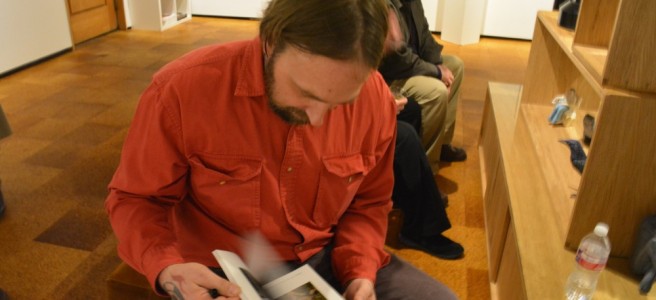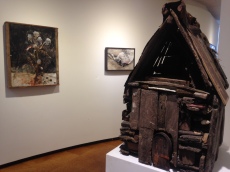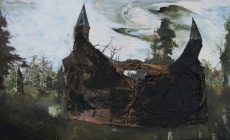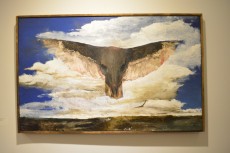All art is autobiographical, Fellini declared. For Miles Cleveland Goodwin, those snippets of his own life experience in rural Mississippi make up his artwork in the current solo exhibition at Valley House Gallery & Sculpture Garden. Living in a city of concrete and glass, Dallasites are far removed from the scenes of the old South. I have never been to Mississippi. But in the works of Goodwin, the relentless process of ruin and abandonment, in an eerie way, looks romantic and comforting.
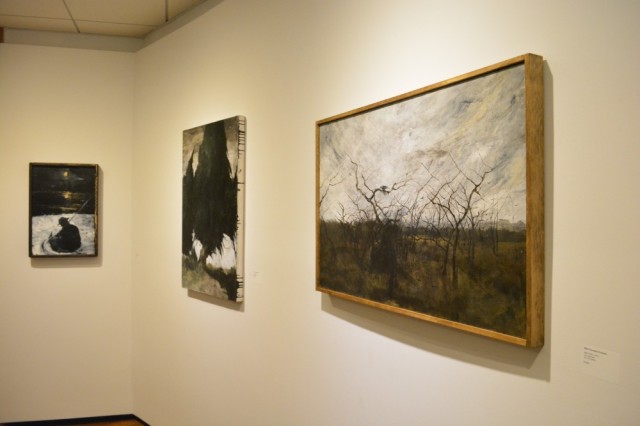
The Deep South, perpetuated in popular culture as a carry-over of the past, maintains its identity in Goodwin’s paintings. A dirt road along rusty barbed wire fences, a clearing with short grass amid a wild forest, or sagging roofs in an overgrown field, are all rendered with laser-sharp authenticity. What is unique is that in many of them, he includes family members and pets. Regardless of their relative proportions and positions, human figures (and pets) always take the central focus. It is through their posture and activities that we see the distilled life experience beyond a landscape reclaimed by natural.
Goodwin excels in his fluidity of narratives — Each picture exudes a sense of becoming, yet stops short of being specific. In the title painting, a boy is barely discernible in a “maze” of a cornfield. A left arm extended across his back to hold the right, he seems to be lost in his thoughts. Goodwin skews the perspective with extenuated corn stalks soaring in the front. Lushly painted, the near-life-sized cornfield looks menacing. But we are assured it is not. The narrow path behind the boy indicates he has trodden through the “maze” many times. The painting serves as a metaphor for life: Despite all uncertainty, people have been there. That is comforting.
As absurd as it sounds, I feel a Watteau-ish melancholy in Goodwin’s people. Their bodies are twisted, faces turned or masked, and their gesture are arabesque. The clarity of what they are doing confronts the vagueness of why they do it in such ways. In their solitude (a distinction from Watteau), Goodwin suggests the resilience of living as a form of beauty, along with silence and mystery.
Goodwin’s rich texture of the paint is a pleasant surprise to view in person. In this, second solo show at Valley House, a few paintings show new directions of the artist by incorporating found objects. It stirs up the creative processes; and sets a departure from purely representational themes. We tend to glimpse through representational art, once we feel it is “read”. Here, an unusual surface, on top of the pictorial space, should at least, hold our attention for a few seconds more. The fact that they are objects found in the same area where paintings were made (outdoors) attests to the affinity between imageries and their root.
In Country Church, Goodwin transformed a found vintage blouse into vernacular architecture – a church with two steeples. The fabric droops and creases into a form with formidable weight. Nature eats into the forlorn building as we see through the fabric. I find the excessiveness of materiality fascinating. Goodwin has gone as far as Rauschenberg’s followers would go, yet the everyday object from the 50s is more than just aesthetics. It serves as a time scale to register the passage of time. Admittedly, it is clumsy at first glance, yet no more than the shabbiness of the imagined church it represents. Together, the object and its imagery form a quirky yet impressive harmony.
In another painting On Black Wings, a tornado is spotted between a pair of wings. According to the artist, it was removed from a dead bird found on the road. The wings, arched above the canvas, took all my attention initially. With the twist in the middle, they bear a resemblance to a dancing ghost. As the initial compulsive feeling resided, I noticed the assemblage in other parts of the canvas — much warmer, and homier. Two dogs are wandering around the house, apparently not aware of the danger. The wings are spooky, but what chills more is the incongruity between a tranquility of continuity in life and the dramatic confrontation of a life-threatening event.
Goodwin has a rich baritone voice, a voice that easily betrays his southern root. Humble and self-deprecating, he is shy in discussing his art. For example, he did not comment when I mentioned his color palates relate to those of Andrew Wyeth. But he did express his fondness of Albert Pinkham Ryder when we met the first time one and half a year ago.
I sense that connection has grown stronger. In this second exhibition, his compositions are leaner and poised to a degree of poetic symbolism. While the cloud depicted is swirling as if to answer to a higher voice, his birds are often semi-transparent, possessing more spirit than forms. In the tightly cropped Cypress Trees, the center one barely fits. Its massive triangular shape, tilted toward the back, has the kind of monumentality as seen in a Ryder moonlight marine painting. But its whispering branches on the peripheral take on the ephemeral qualify of life. You can feel the wind whipping through it, telling all the backroad stories of the past.
Miles Cleveland Goodwin’s “The Maze” at Valley House Gallery is on view through February 11, 2017.
Discover more from Urban Art & Antiques
Subscribe to get the latest posts sent to your email.

